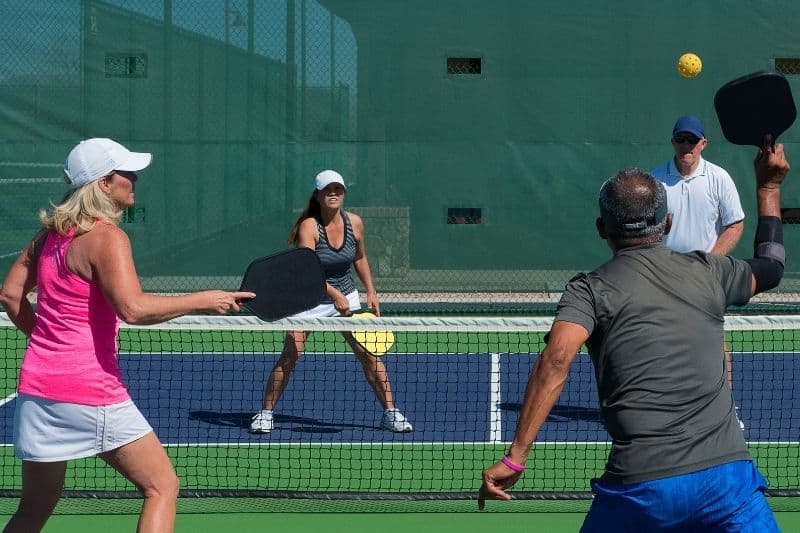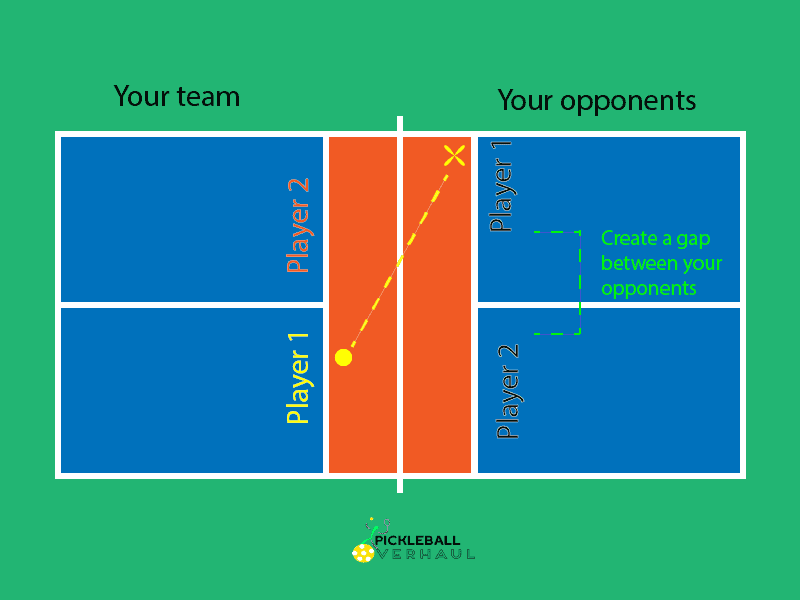
Playing doubles is arguably the most popular way to play pickleball. However, if you’re playing in open-play rec games, you may not be familiar with your partner or how they play. No matter who you’re playing with, understanding pickleball strategy in doubles will improve your game. Let’s get started.
Serve Deep
Serving deep in an important pickleball strategy for both singles and doubles. There are many reasons for this. The first is that the farther the ball is from your side of the court, a good return is harder for your opponent.
Secondly, if your opponent is standing too close to the baseline, they will have to back up or lose their balance. Their return could therefore be a weak one for you or your partner to take advantage of in your third shot.
Return Deep
Returning a service is one that is not often drilled enough or drilled at all among rec players. With so many people having a different style of serving, it is important that you give yourself plenty of room at the baseline, be ready on your toes, and position yourself to return a service deep.
A deep return close to the baseline makes it harder for your opponents to get their third shot right. It also gives you more time to get to the kitchen line. If they choose to drive their third shot from the baseline, the ball will slow down enough by the time it gets to your side of the court that you should be able to block it. If they drop the shot, you will be ready to return it without issues.
Get To The Kitchen Line
You may already know that the main pickleball strategy for doubles or singles is that you need to get to the kitchen line. However, many rec players take this without context and rush to the net mindlessly. You will want to see where your opponents are and where the ball is before sprinting to the kitchen line.
If you or your partner is dropping the third shot, make sure the drop is successful before you rush up to the net. If you’re driving the ball, it could be blocked and bounce back behind you. You want to be in your ready position, no matter where you are on the court while your opponent’s paddle is contacting the ball. Once you make a safe return, you can take steps toward the kitchen line.
Use Crosscourt Dinks To Create Gaps
Many pickleball players know to dink crosscourt when everyone is at the kitchen line. But there are several reasons and strategies for dinking crosscourt than you may realize. The first is that dinking crosscourt is generally safer since there is more area of the court where the ball could land. This is important for beginner and intermediate players who may not know how to accurately place the ball exactly where they may want to.

Secondly, the net clearance in the middle is generally lower than straight across. So you will not have to prop the ball up too high that your opponent can attack the ball.
And the most important reason to cross-court dink is that it forces your opponents to move from their stable, ready position. They will have to take a step sideways to the sidelines to return the ball. Then they will have to remember to step back to their ready position.
This creates many opportunities for your opponent to make unforced errors where they forget to get back to position or to have to use their weaker side such as their backhand. Their partner may also not be moving with the ball, creating a gap between them and the player that is reaching for the ball.
Move With Your Partner
Just as creating a gap between your opponents is a pickleball strategy for doubles, it is as important to be moving with your partner. If your partner is stepping left to reach a sideline shot, make sure you’re also stepping left to cover the middle. The same principle applies to both sides.
If your partner is running to one side of the court, make sure you’re covering the other side instead of staying still in your position. You don’t want to keep a huge gap for your opponents to have an easy putaway because you’re not moving from your position.
Keep The Your Opponents Back
If your team is already at the kitchen line and your opponents are still trying to make their way up, keep them back towards the baseline. If one is already at the kitchen line, hit to the player that is still at the back.
The reason is that it is a lot harder to drop a ball that is unattackable from the further back of the court. If they drive the ball back from the baseline, it will slow down enough for you to block it. And if they don’t drop the ball just right, it will go into the net or bounce high enough for you to attack.
Reset Your Shots To Get Back To Position
Sometimes you or your opponent will lob the ball or smash a ball that forces you to be out of position from the kitchen line. You or your partner may have to run around the ball or hustle deep to the sidelines to get an angle shot back.
In order to get back to your ready position and give your partner time to get back to their ready position, reset the ball enough. This may mean dropping the ball softly or loosening your grip on the handle so the ball can be dinked again.
Communicate
The last and perhaps most essential to playing pickleball doubles is to communicate. Call balls that are yours or theirs. Make the words as short as possible. If a ball is in between, say “mine” or “yours”. If the ball is definitely going out but your partner looks like they’re about to swing, call out “out”.
It is better to call out the shots rather than to assume that you will hit the shot or that your partner will. Especially when it comes to balls that are in someone’s forehand. What is obvious to you may not necessarily be obvious to others. So it is best to communicate and stay silent.
Last Tips
If you’re looking to improve your game overall, you will want to drill. You will find that drilling regularly will improve your skills rather than just playing. All you need is a partner and a good amount of balls to get started. For more tips to level up your game, check out the next few articles.
Read Next: 5 Reasons Why You’re Not Getting Better At Pickleball
Read Also: Must-Know Pickleball Shots To Level Up From A Beginner

